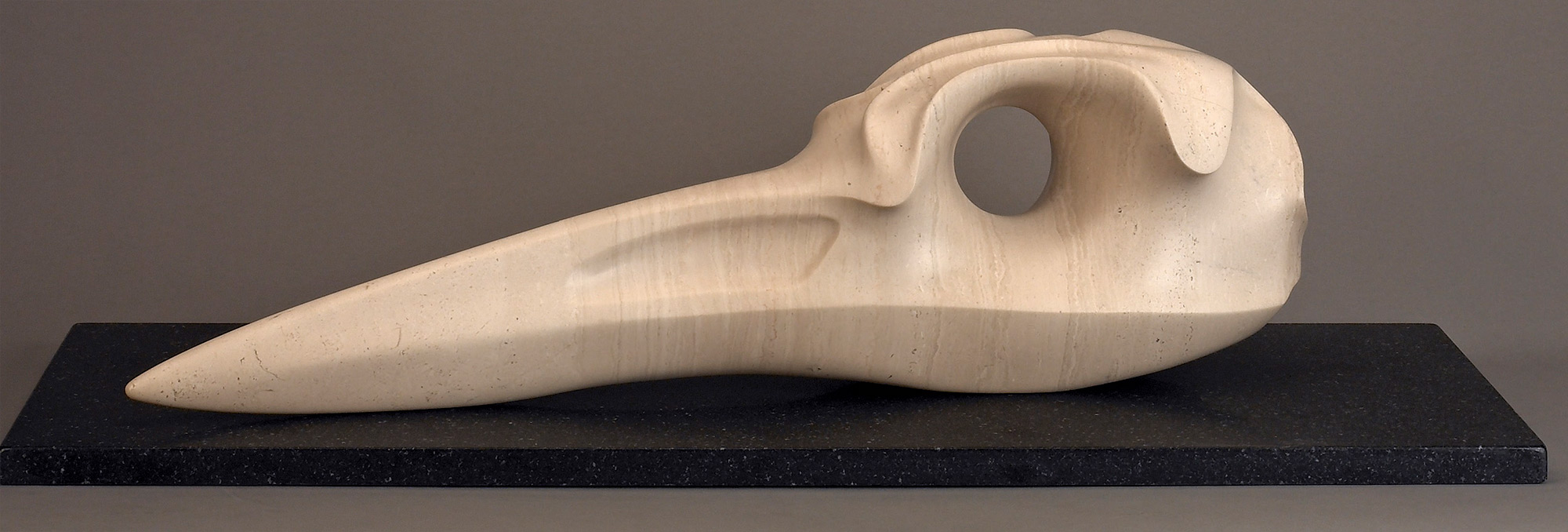
17 Nov The Wild Enigma
INCESSANTLY, ARTISTS ARE ASKED by art writers to toss around names. The names of individuals who lit fires in their bellies or catalyzed the direction of their work. It’s exceedingly rare to find an older living animal sculptor in America whose grasp of three-dimensional forms was influenced by Buckminster Fuller, Willem and Elaine deKooning, and David Smith.
Les Perhacs did not merely come in contact with their architecture, abstract expressionist paintings, sculptures and genre-bending ideas; he received direct hands’-on instruction from the artists themselves — yet another aspect of Perhacs’ extraordinary life that is not so well known.
For years, I’ve been aware of Perhacs as an enigma, his mystique heightened by the reverential regard he commands among colleagues whose work I admire. Occasionally, I’ve also received needling from Maria Hajic, director of the Department of Naturalism at Gerald Peters/Santa Fe, who almost annually invites me to view the latest Perhacs arriving in the gallery.
In spring 2016 while on a road trip across the Southwest, I was in Santa Fe and encountered a rare mass grouping of Perhacs’ exquisite stone carvings, bronzes and abstract metal sculptures, displayed as if in a rare mini-retrospective. I was floored by the range of his diverse oeuvre.
“Perhacs is a visionary and master craftsman. His artistry has flown under the radar because he’s been kind of an iconoclast and a hermit. He doesn’t do a lot of shows, hasn’t really self-promoted his work, has always done his own thing. He’s a character and, as someone celebrating the natural world, an original among his peers,” Hajic says. “It is rare for sculptor working in different media to move so fluidly between abstraction and realism.”
What Perhacs does is far more than that. His sculpture is really about starting, communicating and maintaining an ongoing dialogue about humanity’s relationship to the earth.
Born in Los Angeles in 1940, Perhacs attributes his analytical approach to three dimensions to his Hungarian father, an inventor and engineer, who patiently showed his son the meaning of superior quality in making things. The elder Perhacs said it isn’t enough to solve a problem or build a machine or structure that works well; aesthetics matter; they are the signature of the creator.
As for Perhacs’ love affair with sentient earth, it is his lifelong friendship with internationally-renowned stone carver, Tony Angell, that changed his life.
By sheer kismet, Perhacs and Angell [See WAA feature on Angell] lived only a few blocks apart from one another in the San Fernando Valley. Their bond began in middle school. “We had easy access then to the Los Angeles River and tributaries that still ran semi wild and that's where we could easily walk, plunge in and wander with pals to fish and collect whatever wild specimens came our way,” Angell remembers of an era before the crush of humanity arrived and transformed the LA River into a concrete canal, lined by power polls in place of trees.
“The coast range foothills covered in chaparral were yet to be festooned with multi-million dollar homes and were occupied by mountain lion, abundant deer and even the occasional condor that soared over our heads having come down from Ventura County and the Sespe Canyon,” Angell added in a note to me, penned as a sign.
“Most people don’t think of Southern California as a place where nature loomed large. We were cutting our young teeth on it in a way no longer available to the millions of youth there today, and engendering skills and memories that would influence the rest of our lives.”
For both of them, it left an indelible impression, affecting the way they still orient to the world, causing Perhacs in his work to muse on how he could create artwork that not only awakens the spirit of nature inside viewers but stirs their souls.
As budding naturalists, Perhacs and Angell toyed with taxidermy. “Between the two of us,” Angell says, “Les and I probably skinned a thousand creatures, some of them found as roadkills, to sketch and preserve them, from snakes and frogs to assorted birds and mammals.”
Both learned to draw in field journals though it was Perhacs who first demonstrated a prodigious aptitude. “Les began painting in oils and left all of us wondering how he did it,” Angell says. “As a ten-year-old — think of it! — he was copying Audubon's flamboyant and stylized master portrayals of birds and, by God, Les’ interpretations were, while on a smaller scale, equally impressive to the young eyes of his pals. He had a similar facility as a taxidermist bringing a dead animal to life like none of the rest of our gang could do.”
Perhacs’ talent was quickly recognized by adults, winning him a scholarship to study at Chouinard Art Institute while he was still a mere 16-year-old at North Hollywood High. From there, he spent a year at the Art Center College of Design and then moved on to Pratt Institute in New York. Pratt had a sterling reputation for rotating through a distinguished roster of visiting guest faculty and Perhacs had studio and theory classes taught by the deKoonings, Willem [1904-1997] and Elaine [1918-1989], Buckminster Fuller [1895-1983], and David Smith 1906-1965].
Looking back, he says that, with his primary interest being in architecture and industrial design, he was keenly aware of Fuller but he didn’t fully comprehend the stature of the deKoonings and Smith, their visionary genius as modernists and abstract expressionists, until he reached his twenties.
“Coming to Pratt from Chouinard and Art Center College of Design, where the emphasis was on classical painting and drawing with a grading structure, I was taken aback by their statements ‘forget everything you’ve been told – you’re here to learn a new visual modernist language of form follows function — Bauhaus — in which the primary objective is to express yourself,” he says.
What they were really emphasizing was liberation, Perhacs says, to be authentic in one’s interpretation; not to altogether reject classicism but to consciously resist becoming a romantic captive to the past. It was also a radical departure from the traditional method of representing animals — illustratively — and forced him to contemplate the iconography of living things, the way they rise as archetypes in a society surrounded by metal, steel and glass, and yet can become visible as extensions of the human built world where most people on earth dwell but forget their connections.
All four of Perhacs’ star instructors were extremely driven, he says, and their demands of students high. “They did not teach their own styles, but rather a process of visual problem solving,” he says. “It proved to be the most valuable and exciting segment of my formal education and continues to serve as the thought process for my work.”
At first, Perhacs felt stymied by his assignments from Willem deKooning in a class called Foundation: Two-Dimensional Design. “His instructions were vague, things like ‘Make something big’ or ‘Give me a windblown tree without rendering a tree”; or ‘portray the crunch of an apple visually without stating it literally’”.
“I came to realize the value of those exercises– juxtaposition, gesture, and the purposeful placement of each form or line,” Perhacs says. “At the start of each class, we were made to pick one piece from our homework that we thought ‘best got the lesson’ and post it on the wall for critique. Then we had to explain why every element was there. If there wasn’t a good explanation, it was deemed extraneous and therefore, unnecessary – and rip, down it came. Painful at the time, but now I realize the impact that had. The point: to free us of thinking literally.”
In hindsight, deKooning’s thought exercises became drivers in Perhacs’ approach to conceptual sculptural design that he still carries forward. “Mr. deKooning said, ‘The first line on your paper is actually the fifth visual line so learn to deal with edges.’ This held great appeal to me having been immersed in the natural world since my youth where I saw there were no lines, only edges,” he explains.
De Kooning was intense, direct, had a damned good sense of humor and was very down to earth, but extremely demanding, he says. Assignments took four to five hours each night to complete, always with a focus on the relationship of forms and space that he felt were equally important.
In New York, Perhacs felt too hemmed in. He entered the Industrial Design and Architecture Program at the University of Southern California. There, all of his diverse paths converged. He won the National Alcoa Aluminum Student Design Award in 1962 for his “tractor for the sea.” His invention was a battery-powered surface saucer which served as a platform for divers and the mariculture industry, informed by his skin-diving adventures with the design itself inspired by the Mexican guitarfish.
“The award was a culmination of ‘form follows function’ learned at Pratt,” he says. “I considered the piece to be a ‘utilitarian sculpture’ and saw no difference between my approach to art, sculpture, and a design project – working with problem solving until I was satisfied with the viability of the piece.”
Along the way, he had been selling his art as carvings and bronzes. Not long afterward, Perhacs’ gifts in engineering led him to another unexpected place where he drew upon his earlier taxidermy experience deconstructing and reconstructing animals.
He was recruited to be a model maker and inventor at the famed Toy Development Center in Los Angeles, where he was part of teams that created toys and games for Hasbro, Mattel, Milton Bradley, A.C. Gilbert, and Cragstan — objects that have been enjoyed by billions over the years. He also crafted studio props for Universal Studios, and the television shows Star Trek and Man from UNCLE.
His stint there was a period of intense reflection on the power of tactility — that which is conveyed through touch and connection, pondering the visual aesthetic signals sent to viewers based upon an object’s design and power of interaction.
“The production process is a vital part of creation – but if it was too complicated, it wouldn’t be viable. The same applies to nature,” he says. “Over-complication and specialization leads to extinction, and I worry about where our society is headed. I viewed my contribution in toy design as a means of stimulating thought and coordination for children; the same as I attempt to stimulate thought in my sculpture.”
In some ways, Perhacs is a frustrated architect but he went on to build monuments, instead of buildings, that pique and soften the senses. He believes that best public urban art serves as bridges between nature and the build environment. He points to one of his favorite installations, “Fort Worth Water Gardens”, designed by Phillip Johnson and John Burgee. It is described as a “cooling oasis in a concrete jungle.”
At San Diego International Airport, Perhacs' monument to loons, “In Search of Wilderness” was installed in 1998. The piece celebrates a mated pair of migrating birds in flight, carrying a precious single egg over the dome of the earth. San Diego is positioned in their flyway which extends from breeding grounds in Alaska to winter range off the coast of Mexico.
Closer to home, in Fallbrook, Perhacs sculpture is a prominent visual fixture in Palomares Park not from the headquarters of the Fallbrook Land Conservancy. At the entrance to the park’s sculpture garden, you’ll find Perhacs’ “The Chase” that portrays a fox chasing two rabbits in three different but interacting forms.
While those works over the years have greeted millions, it’s his one-of-a-kind carvings and metal sculptures and limited edition bronzes that are touchstones for collectors. “I’m fascinated by structures in nature, and particularly skulls with their beautiful curves, edges, and cavities in which muscles are attached – all with a very particular function,” Perhacs says of his striking piece “Ambassador of Time”. “After having found a loon skull on a beach many years ago, I knew I wanted to make a sculpture, but not in metal. When I obtained a large oblong block of Carrara marble, I knew I had found my vehicle.”
“His organic pieces have a beautiful natural rhythm,” says George Carlson, the legendary painter and sculptor. “I like how he investigates the stone to get the best color. It all works in harmony as if it’s growing out of the earth. It’s deep nature based on a profound understanding of the environment. He’s like the artist’s version of Loren Eiseley.”
In the direct-carving method, artisans only get one bite at the apple. There are no do-overs with a piece of rock. “There are no superfluous details; the emphasis for Les is on the relationship between the curvatures and planes of his designs,” Gerald Peters’ Hajic says. “His work encourages the viewer to interact with them both emotionally and intellectually and, thereby, delve deeper into the subject and the experience.”
The greatest stone carvers, besides possessing vision and skill of tools, possess another inimitable trait: intuition — powered by an ability to refrain from imposing their will upon the rock, instead following its geological composition as they move deeper into its mass, letting unexpected revelation guide the work’s design.
“I think Les has a way of working with stone that is not unlike Steve Kestrel,” Angell says. “He really considers its possibilities — something that every stone carver strives to achieve. Les sees and realizes patterns in the stone to incorporate into his designs. The existing shapes of the material become the subject and the colors he brings forward expand and celebrate that subject and its moment in time. “
Among the other sculptors he admires, besides Angell, Kestrel and Carlson, are Eduardo Chillida, Isamu Naguchi, Fletcher Benton and, Jack Zajac. “Each is able to bring their forms down to the simplest denominators in which you could actually see the purpose of the piece – nothing extraneous – very emotionally powerful work,” he says.
Perhacs, like Angell and Kestrel, does not believe he is liberating the spirit of ancient rocks; rather he’s helping it find a visual voice, a means of speaking to the viewer.
“Les is a brave experimenter, un-afraid to explore new artistic terrain,” Kestrel says. “In his stone carvings, he is able to distill animal forms down to bare essentials while still retaining a beauty and grace that resonates with the viewer,” says Kestrel. “I should also mention that he uses the colors, natural forms and texture of the stone to maximum advantage for the image being carved.”
With his bronze “Northwest Mysteries,” a raven head rises like a totem on a rotational base. “When I made this work, it had been a long time since I had used the raven as the subject matter for a sculpture. The idea came to me while I was gathering firewood from our avocado grove. My wife saw a log that immediately reminded her of a female figure. When she showed it to me I said, ‘Great, I know exactly what I’m going to do with that, add a raven head to the female log form.’”
The work, Perhacs says, draws upon his own days in the Pacific Northwest where he interacted with native people and researched the stories behind their wildlife iconography. The piece pays tribute to the Haida peoples’ reverence for the raven as having discovered the first humans.
“My wife, although intrigued, thought I was nuts to spend so much time on such a project. However much to our delight, a long-time collector came by within a month of the piece being finished. The individual was overcome with emotion and purchased the first casting,” Perhacs says. “I consider it one of my pivotal works.”
Perhacs’ mixed media works in metal are distinct. He has literally scrapped works in progress after weeks of toil and started over. “Mistakes are a very important part of the work,” he says.
“They force me to consider something I would not have preconceived.” Mistakes, he says, are the birthplace of the new.”
Perhacs reflects on what Buck Fuller was trying to say to his young, influential charges. Fuller was a green post-modernist. He advanced the notion of our planet as “spaceship earth” and, more famously, became synonymous with touting the virtues of the geodesic dome as biosphere-friendly design. For him, art and living were inseparable, central to his principles of “doing more with less.” Arguably, Perhacs sculptures are exponents of Fuller’s belief that “life is the spirit incarnate in time.”
What he awakened in Perhacs was not only a passion for exploring creative ways to use new and old materials but in identifying context for content, i.e. how the placement of art in public places can have impact.
“I used to think that Les’s stone pieces were his strongest works, but having seen his non-objective ‘Chaos Series' over the last 10 years, I’d have to say it’s a toss-up for me, for he has mastered that medium and imagery equally well.” Kestrel says.
Perhacs isn’t only interested in celebrating beauty; he wants the human mind to ponder metaphysics. In his “Chaos Series,” he interprets nature through geometry. “Chaos is the environment in which these forms exist. While the series is perceived to be abstract, I see it as exploring a different form of realism because as you look at nature’s building blocks, you discover the forms are geometric.”
With each creation, he starts with a simple geometric form – circle, rectangle, square, or triangle — and then breaks them apart “unfolding” them to show motion and ultimately to reveal the elegant organization of nature in life forms perfected through millions of years of evolution or even rocks billions of years old.”
Art as a visual language can be a very powerful tool to make an impact on our collective consciousness. “My ultimate goal for all my work is motion and emotion –striving to achieve pieces that motivate the viewer to look further beyond the image and explore with their senses.
For him it always comes back to humility.” The idea that Man is the most important creature in our universe is absurd. When we think of our own existence with humility, you can grasp the bigger picture and when you see it, it alters your awareness.”
Perhacs reflects back on those carefree days when the forces of nature still had a dominant presence in the San Fernando Valley. His work speaks to our yearning for natural connection.
“Les' work makes me reach,” Angell says. More than 60 years ago, no one could have predicted that from their modest street in the suburbs these boyhood friends would become notable, powerful translators of the world around us.
“I have always come away, not just enjoying something Les has created, but thinking about it and wondering: ‘Now, where is he going with it?’ Nothing is ever simple in a Perhacs,” Angell says. “I'm attracted to his work because I know where he’s been, because I always come away challenged at times to broaden my perspective. I feel enriched, provoked to think, and often inspired.”
- “Merganser” | Limestone | 18.5 x 7.5 x 12 inches | All photos courtesy of Gerald Peters Gallery
- “Roadrunner” | Fabricated Steel | 8 x 5 x 24.25 inches | All photos courtesy of Gerald Peters Gallery
- “Life Mates” | Belgian Black Marble | 10 x 22 x 10 inches | All photos courtesy of Gerald Peters Gallery
- “The Ritual” | Bronze | 8 x 25 x 18 inches
- “Swallows” | Fabricated Steel 10 x 11 x 10 inches
- “Nesting” | Wyoming Serpentine | 12.5 x 16 x 13 inches | All photos courtesy of Gerald Peters Gallery
- “Seed Pod” | Fabricated Steel | 33 x 13 x 18 inches | All photos courtesy of Gerald Peters Gallery







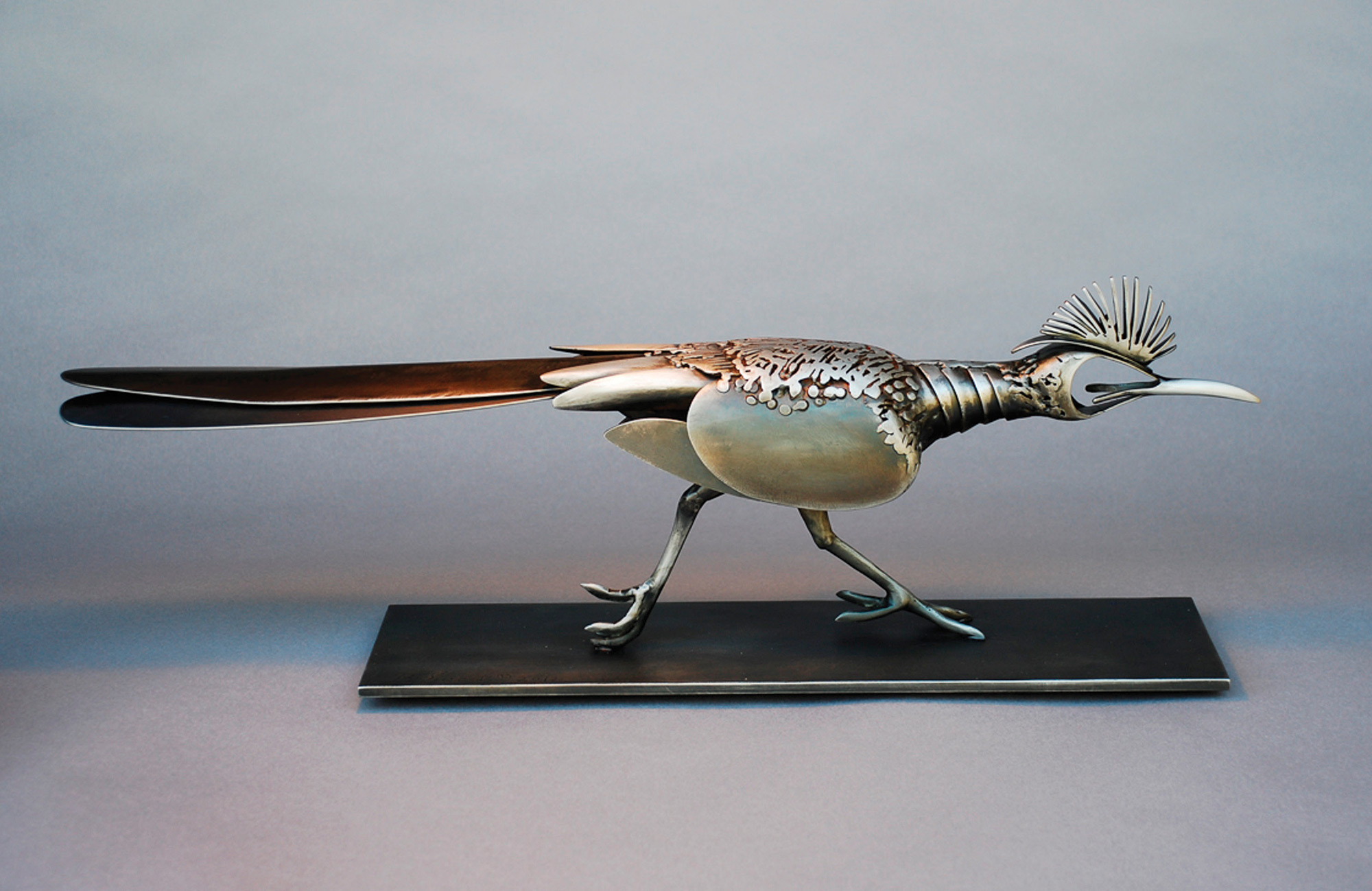

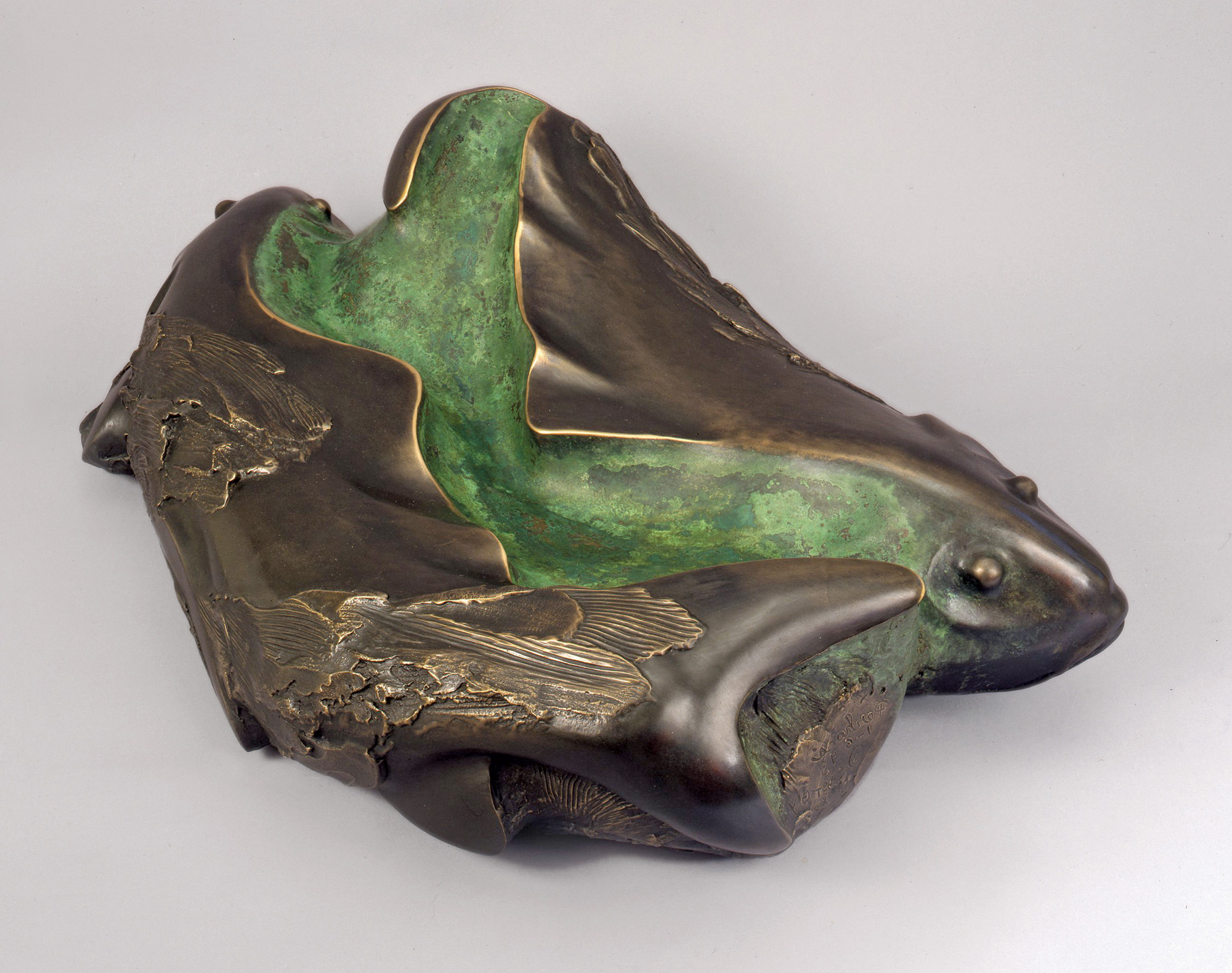
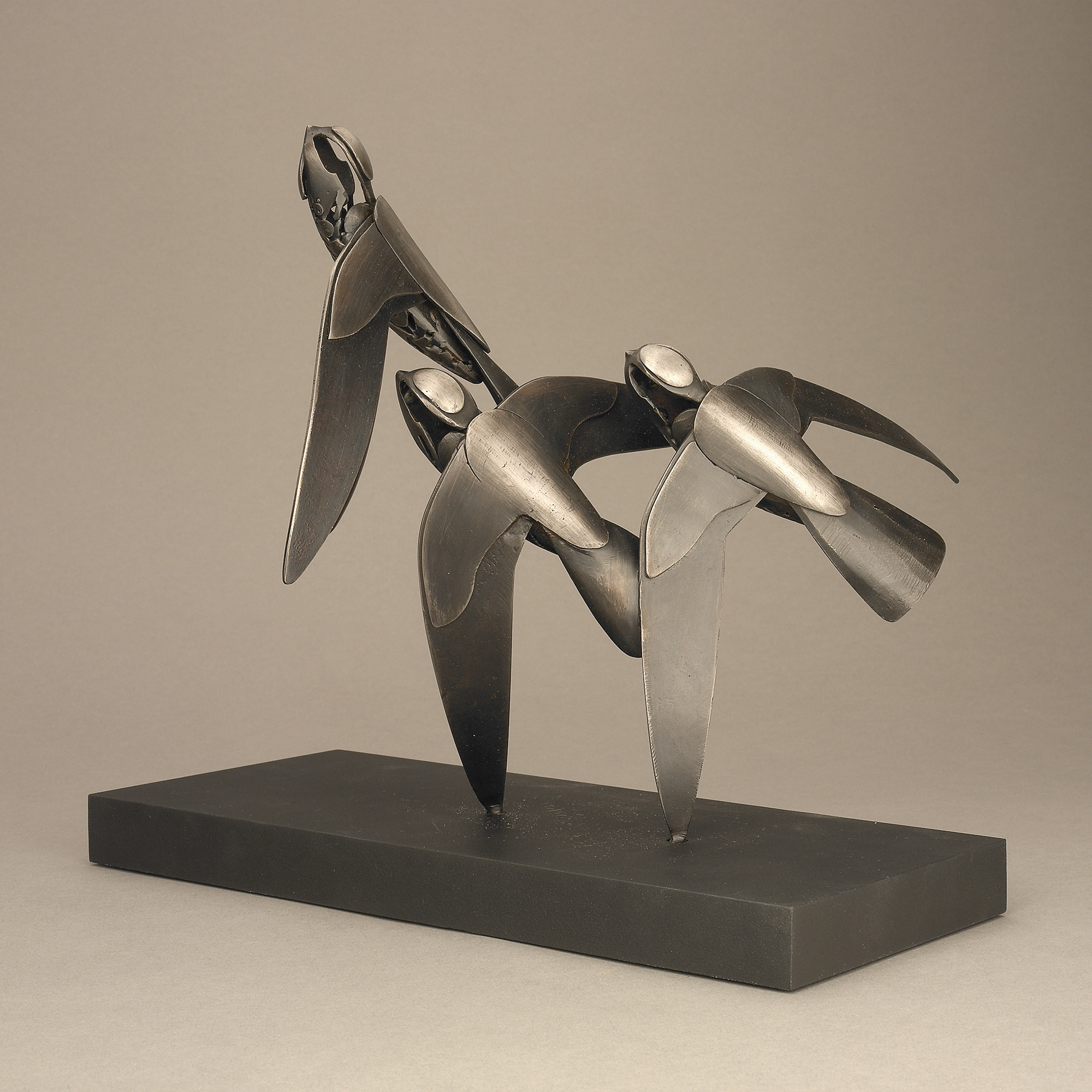
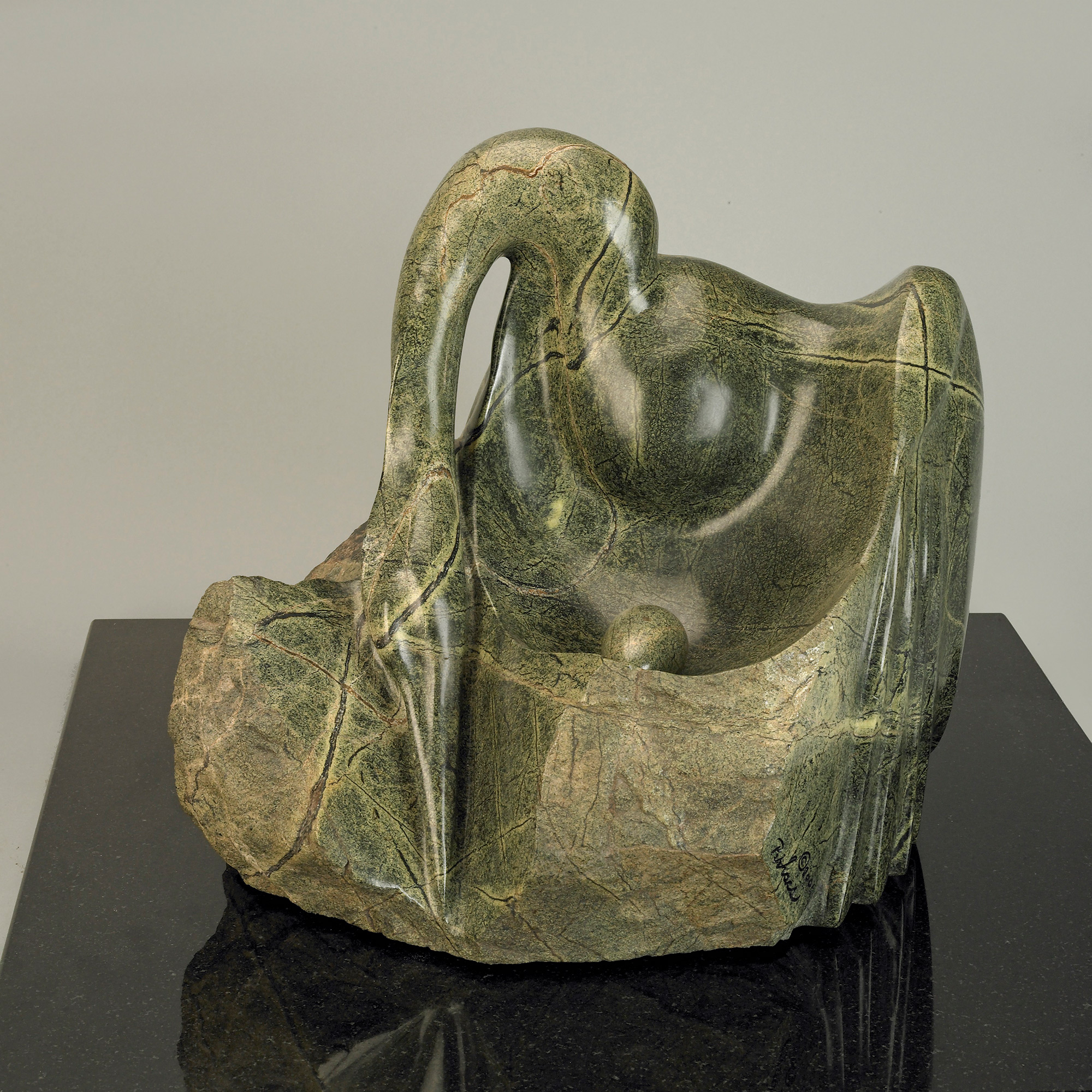
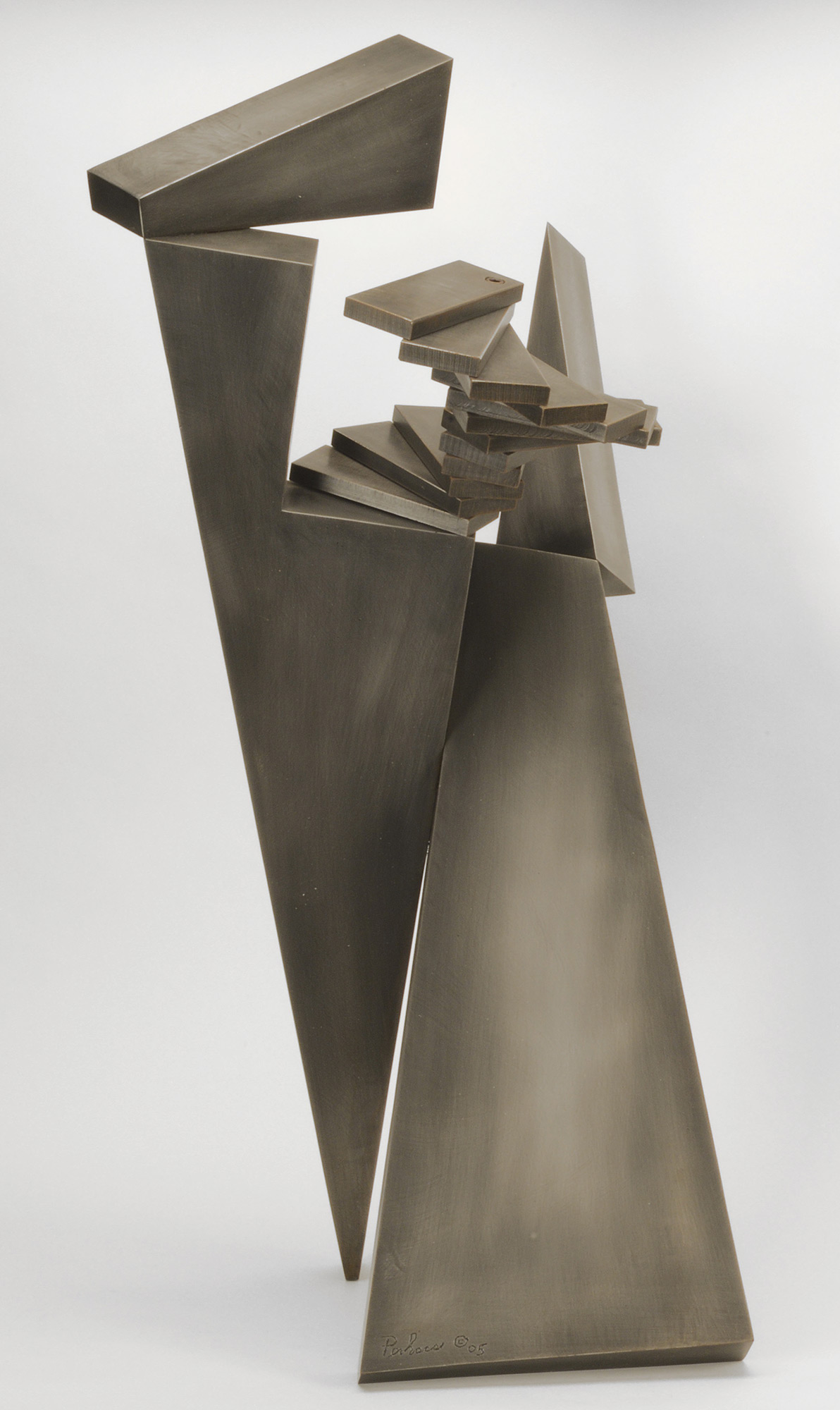
No Comments